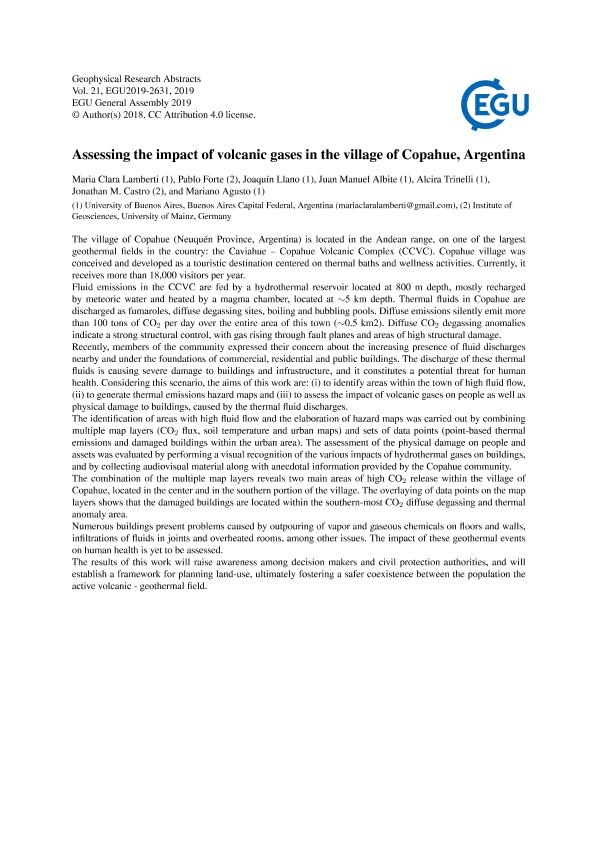Evento
Assessing the impact of volcanic gases in the village of Copahue, Argentina
Lamberti, María Clara Isabel ; Forte, Pablo Brian
; Forte, Pablo Brian ; Llano, Joaquin
; Llano, Joaquin ; Albite, Juan Manuel
; Albite, Juan Manuel ; Trinelli, María Alcira
; Trinelli, María Alcira ; Castro, J.; Agusto, Mariano Roberto
; Castro, J.; Agusto, Mariano Roberto
 ; Forte, Pablo Brian
; Forte, Pablo Brian ; Llano, Joaquin
; Llano, Joaquin ; Albite, Juan Manuel
; Albite, Juan Manuel ; Trinelli, María Alcira
; Trinelli, María Alcira ; Castro, J.; Agusto, Mariano Roberto
; Castro, J.; Agusto, Mariano Roberto
Tipo del evento:
Congreso
Nombre del evento:
EGU General Assembly 2019
Fecha del evento:
07/04/2019
Institución Organizadora:
European Geosciences Union;
Título de la revista:
Geophysical Research Abstracts
Editorial:
Copernicus Publications
Idioma:
Inglés
Clasificación temática:
Resumen
The village of Copahue (Neuquén Province, Argentina) is located in the Andean range, on one of the largest geothermal fields in the country: the Caviahue ? Copahue Volcanic Complex (CCVC). Copahue village was conceived and developed as a touristic destination centered on thermal baths and wellness activities. Currently, it receives more than 18,000 visitors per year.Fluid emissions in the CCVC are fed by a hydrothermal reservoir located at 800 m depth, mostly recharged by meteoric water and heated by a magma chamber, located at ~5 km depth. Thermal fluids in Copahue are discharged as fumaroles, diffuse degassing sites, boiling and bubbling pools. Diffuse emissions silently emit more than 100 tons of CO2 per day over the entire area of this town (~0.5 km2). Diffuse CO2 degassing anomalies indicate a strong structural control, with gas rising through fault planes and areas of high structural damage.Recently, members of the community expressed their concern about the increasing presence of fluid discharges nearby and under the foundations of commercial, residential and public buildings. The discharge of these thermal fluids is causing severe damage to buildings and infrastructure, and it constitutes a potential threat for human health. Considering this scenario, the aims of this work are: (i) to identify areas within the town of high fluid flow, (ii) to generate thermal emissions hazard maps and (iii) to assess the impact of volcanic gases on people as well as physical damage to buildings, caused by the thermal fluid discharges. The identification of areas with high fluid flow and the elaboration of hazard maps was carried out by combining multiple map layers (CO2 flux, soil temperature and urban maps) and sets of data points (point-based thermal emissions and damaged buildings within the urban area). The assessment of the physical damage on people and assets was evaluated by performing a visual recognition of the various impacts of hydrothermal gases on buildings, and by collecting audiovisual material along with anecdotal information provided by the Copahue community.The combination of the multiple map layers reveals two main areas of high CO2 release within the village of Copahue, located in the center and in the southern portion of the village. The overlaying of data points on the map layers shows that the damaged buildings are located within the southern-most CO2 diffuse degassing and thermal anomaly area.Numerous buildings present problems caused by outpouring of vapor and gaseous chemicals on floors and walls, infiltrations of fluids in joints and overheated rooms, among other issues. The impact of these geothermal events on human health is yet to be assessed.The results of this work will raise awareness among decision makers and civil protection authorities, and will establish a framework for planning land-use, ultimately fostering a safer coexistence between the population the active volcanic - geothermal field.
Archivos asociados
Licencia
Identificadores
Colecciones
Eventos(IDEAN)
Eventos de INSTITUTO DE ESTUDIOS ANDINOS "DON PABLO GROEBER"
Eventos de INSTITUTO DE ESTUDIOS ANDINOS "DON PABLO GROEBER"
Eventos(IGEBA)
Eventos de INSTITUTO DE GEOCIENCIAS BASICAS, APLICADAS Y AMBIENTALES DE BS. AS
Eventos de INSTITUTO DE GEOCIENCIAS BASICAS, APLICADAS Y AMBIENTALES DE BS. AS
Eventos(INGEIS)
Eventos de INST.DE GEOCRONOLOGIA Y GEOLOGIA ISOTOPICA (I)
Eventos de INST.DE GEOCRONOLOGIA Y GEOLOGIA ISOTOPICA (I)
Citación
Assessing the impact of volcanic gases in the village of Copahue, Argentina; EGU General Assembly 2019; Viena; Austria; 2019; 1-1
Compartir



